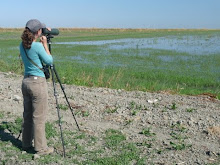Before I left, many people asked me what the food was like. I found it difficult to describe and now I know why. Most of the food is, in a word, bland.
This is not to offend anyone, but
Uruguay and most countries in
South America are not known for their use of spices.
Salt is the preferred spice.
I am fortunate however, that we make most every meal ourselves and I can experiment adding different spices to the dishes; although I have learned that the delicate palettes here can detect even the slightest addition of cayenne pepper!
Unfortunately, I haven’t been snapping pictures of the creations that have come out of the kitchen here and it’s too bad because most of them have been wonderful.
When Brett was here, he concocted pastry crust from the rice flour and cornstarch and it was wonderful for a quiche.
In addition to blandness, there isn't a whole lot of variety either. We eat lots of morons, cebollas, zapallos, papas and combine them in many ways to create as much variety as possible: pasta with sauce, quiches, bean stew… I tried curried garbanzo beans once but I don't think that went over so well. The most frequent accompaniment to our dishes is rice; one of the group is gluten-intolerant. Fortunately, gluten-free pastas and cookies have recently hit the market here in Uruguay. We usually prepare one large meal per day which is good because cooking for 4-5 people everyday quickly becomes exhausting with limited kitchen supplies. Breakfast is always small and consists of only a few crackers with dulce de leche, queso or membrillo. The other meal is usually taken in the field and is snacks of fruta, huevos duros, yogurt, queso and whatever else looks good when we pack the cooler.
Meat is very important here and many people prefer meat and potatoes much like in the United States. Asado is the preferred way of eating meat which is made by cooking meat (any meat) on the parilla. Here they still have carnicerias, or butcher shops, and you can have the pleasure of choosing your animal and watching them chop, saw, or slice off your particular cut of meat. Even in the supermercados, your choice cut is still sliced from a larger piece. Pre-packaged cuts are available but not common. Again, I am fortunate to have the option of creating non-carne meals in the comfort of our home in Balneario Ipora.
Dairy products are also very important here. The cheese, milk, and yogurt are all produced in country and are exceptional (maybe because the cows are grass-fed;). The cheeses that we eat regularly are like those that have to be searched out as specialties in the U.S.; Colonia, which comes in different flavors from creamy and mild to hard and sharp, and Danbo (like a farmer’s cheese). There are, of course, not so great cheeses also, processed cheeses much like Kraft Velveeta but we stay away from these or when I am looking for something new to try, I only make the mistake of buying it once.
There are ample fruterias (fruit and vegetable stands) however Uruguay is not in the tropics and many of the exotic fruits that people may think of when they hear South America (papaya, guava) are not here. That said, you can get cheap mangoes and pineapples and watermelons. While the fruits and vegetables are overall inexpensive they are often not very fresh since most things travel through Montevideo first before heading elsewhere in the country.
Something we’ve lost in the U.S. is the small corner market where you can run for eggs or milk when you realize you’ve run out in the middle of a recipe. Here, these places still exist and are known at almacens. They can be found on almost every corner and are usually chock full of anything and everything you can think of. The supermercados and hipermercados have made their way onto the scene down here. For bulk shopping, like we have to do, they are convenient but it is nice to know that the corner store still exists.

 Of course at midnight, there were fireworks in the neighborhood. And I participated in one more tradition. For travel in the New Year, Cesar’s family packs a suitcase with a few items and walks around the block. I only had my muchila from the field but went with this nonetheless. Since I was spending New Year’s already traveling in a foreign country, I figured this gave me a leg up on the tradition.
Of course at midnight, there were fireworks in the neighborhood. And I participated in one more tradition. For travel in the New Year, Cesar’s family packs a suitcase with a few items and walks around the block. I only had my muchila from the field but went with this nonetheless. Since I was spending New Year’s already traveling in a foreign country, I figured this gave me a leg up on the tradition.

